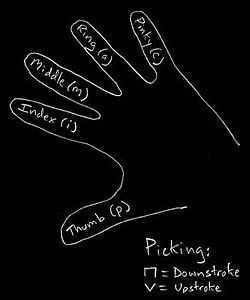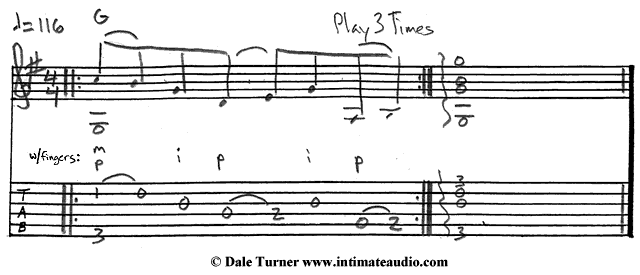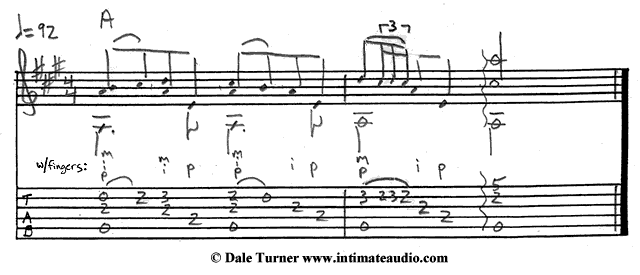|
|
OPEN CHORD ORNAMENTATION
(w/Fingerstyle Technique)
Sick
and tired of playing the same old arpeggio patterns every time you
use your fingers to pluck out open-position “cowboy” chords
on your acoustic guitar? Perhaps you're having a hard time integrating
your well-honed classical guitar
technique into “pop/rock” acoustic guitar playing?
Well... it's high time you took some tips from tasty folk-rock fingerstyle phenoms like James Taylor, Paul Simon, John Denver, Joni Mitchell, Jim Croce, Dan Fogelberg, Stephen Stills, Nick Drake, Gordon Lightfoot, among others, and start coloring your chords with melodious embellishments!!
In other words, consider spending some time studying how to add single-note ornaments to your common chord shapes.
As
you'll soon see, the above-described sounds
surface in every conceivable acoustic guitar style (not just folk-based
pop/rock), a mainstay in the
recorded work of revered pluckers
ranging from Eric Clapton (Unplugged) and Jimmy Page (acoustic
Led Zeppelin), to relative newcomers
like John Mayer, Dave Matthews, Joseph Arthur, Elliott Smith, John
Frusciante, Ani DiFranco, and others. Even “Lilith Fair”
icons like Jewel, Lisa Loeb, Sarah McLachlan, and Shawn Colvin make
it standard practice to avoid playing obvious fingerstyle patterns,
supplementing their open chord shapes with ornamentation moves.
Without
further ado, in this acoustic guitar lesson (featuring TAB, standard
notation, and MP3 audio support) we'll take a closer look at common
“open position” chords like E,
Em, A, Am,
D, Dm, C,
G, and B7, fingering
them in traditional fashion, but tacking on tasty tones to them.
Sound tantalizing? Let's give a few of these patented plucking passages
a try...
A
Note On Acoustic Fingerstyle Technique
|
To
the uninitiated, playing “fingerstyle” means using a specific
combination of your plucking hand's fingers to articulate certain
strings. In proper fingerstyle notation, to eliminate the guesswork
over which fingers are used, symbols are often included between
the notation and TAB staves. Since much of the early “classical
guitar” repertoire stems from Spanish guitar literature, these
symbols are actually an abbreviation of the Spanish names for fingers—p
(“pulgar,” or “thumb”), i
(“indice,” or “index” finger), m
(“medio,” or “middle” finger), and a
(“anular,” or "ring" finger). In traditional classical
guitar pieces and/or exercises, the thumb (p) is typically assigned
to play the bottom three “wound” strings (strings 4-6),
while the remaining fingers (i, m, and a) are used to pluck the
3rd, 2nd, and 1st strings, respectively. (Note:
The “pinky,” or “c,” is rarely used in classical
fingerstyle technique; it does, however, get called upon when Flamenco-based
approaches are employed.) The following graphic should help clarify
the various “plucking hand” terms and symbols you'll see
in this lesson:

For
what it's worth, after you run your fingers through the following
figures, consider also learning them using hybrid picking—using
both pick and fingers to achieve a “fingerstyle” effect.
Many steel-string acoustic stylists use this approach as an alternative
to “traditional” fingerstyle playing to minimize the risk
of shredding their fingernails (if they also play nylon-string,
for instance). For more on hybrid picking, refer to PsYcHo LiCkS'
recent Travis Picking
lesson. As for the MP3 audio examples herein, I played them all
fingerstyle, angling my fingers in a slight manner so that only
my fingertip pads touched the strings, preserving my fingernails.
Let's
kick this lesson off by adding a single extra note—the note
“A” (2nd fret, 3rd string)—to a garden-variety
open E chord arpeggio pattern [Fig.
1]. Given that your fret-hand's index, middle, and ring
fingers are already involved in grabbing the chord's primary notes
(an “E” triad: E-G#-B), your pinky will be used in quick
“hammer-on” fashion to color this chord. In analysis
of the E major scale—E-F#-G#-A-B-C#-D#—you can see simply
by counting scale steps (E=1, F#=2, G#=3, etc.), that “A”
is the “4th” degree of this scale. Whenever a chord's
“3rd” (in this case, the note G#) is replaced by a 4th
(in this case, the note A) a “sus4” sound results. This
is an abbreviation of the term “suspended 4th.” This
particular note functions as a “suspension” because
it “suspends” a chord's resolution—i.e., temporarily
avoids settling in a clear-cut major (E) or minor (Em) tonality.
As you'll see in forthcoming examples, the use of the “sus4”
is almost mandatory when it comes to coloring cowboy chords!
Note:
Make every effort to keep all your fingers anchored throughout,
adding/subtracting only the pinky to the picture. Perform all
other examples to similar effect (i.e., keep fingers depressed
as much as possible).
By
grabbing the “G” root (3rd fret, 6th string) of an
open G chord with your fret-hand's ring finger (keeping it anchored
throughout), your remaining digits become available to add all
sorts of ornaments to this shape. For instance, in Fig.
2 below, the index finger can be used to pull-off from
“C” (1st fret, 2nd string) to the open B string. Meanwhile,
the middle finger can be used to hammer-on extra tones like
E (2nd fret, 4th string) and B (2nd fret, 5th string). Within
the G major scale (G-A-B-C-D-E-F#), this hammer-on/pull-off
activity adds notes like the “sus4” (the note C) and
the “2nd” (the open A string) and “6th”
(the note E) to a G triad (G-B-D). The addition of these latter
tones (the 2nd and 6th to a major triad)
imparts a G major pentatonic (G-A-B-D-E) flavor. In addition
to the ever-present “sus4,” in
later examples you'll see how using notes from a chord's related
pentatonic scale (G major pentatonic over G, C major pentatonic
over C, A minor pentatonic over Am, etc) is equally important
when it comes to adding ornaments to open chords!
 |
|
|
In
this D chord example [Fig.
3], which is somewhat inspired by James Taylor's “Sweet
Baby James,” your fret-hand's pinky and middle fingers
will be added/subtracted to the chord's core tones (D-F#-A),
used to play a “sus4” G (3rd fret, 1st string) and
hammer-on/pull-off an F# (2bd fret, 1st string) to/from the
open E string. As it relates to the D major scale (D-E-F#-G-A-B-C#),
these pitches are the 2nd (E) and 4th (G) scale degrees. All
your fret-hand's remaining fingers (the index and ring) should
be used to hold down the D chord's remaining pitches, adding
the thumb to the picture to play F# (2nd fret, 3rd string)
at the downbeat of measure 2. In the event you find it difficult
to hammer-on/pull-of the notes along the high E string while
the chord is held, check to be sure your ring finger's tip
(pressed on the “D” at the 3rd fret of the 2nd string)
is fretting straight down on the string, otherwise that fingertip's
pad might end up touching the 1st string, making pull-offs
unnecessarily difficult.
From
a practical performance standpoint, you've likely noticed
that the figures in this lesson all work as great “song
ending” moves, among other things. This
next passage is no exception!
In
the following C chord example [Fig.
4], you'll need to keep both “C” notes
(1st fret, 2nd string/3rd fret, 5th string) depressed throughout
(using your index and ring fingers), while your pinky and
middle fingers get tied in knots to grab D (3rd fret, 2nd
string), F (3rd fret, 4th string) and A (2nd fret, 3rd string)
pitches. In familiar fashion, this maneuvering adds the
ol' “sus4” (F), as well as C major pentatonic
pitches (C-D-E-G-A) to a basic major chord, C (C-E-G). Remember:
Let 'em all ring together by keeping your fingers depressed
(*sniffle*) as long as humanly possible!
Interestingly,
Am (A-C-E) can be embellished using a similar approach
to that which we used in the previous C chord. Only in
this case [Fig.
5], we'll be focusing on pitches from the Am chord's
related A minor pentatonic scale (A-C-D-E-G), using our
fret-hand's pinky to tack on “D” (3rd fret,
2nd string), and our ring finger to hammer-on/pull-off
to/from open G (3rd string) and D (4th string) notes.
If
you've played guitar for a few months (or more), you've
probably noticed that some of the most common open chords
can be grouped into major and minor pairs—like
E and Em, A and Am, D and Dm, for instance. Since we
already worked on embellishing a standard D chord (D-F#-A),
let's take a close look at what we can add to it's Dm
(D-F-A) counterpart.
In
Fig.
6, a Dm chord is grabbed using the traditional
fingering. Then, while all of its notes are held down,
the open E string is sounded from a pull-off (from F
at the 1st string's 1st fret), and the A on the 3rd
string (2nd fret) is preceded by a hammer-on from the
open G string. This adds both the 2nd (E) and 4th (G)
scale degrees to our Dm sound, borrowed from the D natural
minor scale (D-E-F-G-A-Bb-C). Interestingly, this Lyndsey
Buckingham-like figure sounds not unlike certain Travis
Picking patterns we studied a couple months
back.
Measure
1 of Fig.
7 illustrates a James Taylor-like treatment of a basic A
chord shape (A-C#-E). Finger this chord (from low to high) using
the middle, ring, and pinky fingers, otherwise the hammer-ons/pull-offs
to/from the open B string won't be very playable. (Note: James Taylor
actually plays his A chord shapes so that his index finger
can be used to hammer-on/pull-off along the 2nd string!) Your pinky
will also need to be shifted along the 2nd string to grab C# (2nd
fret, 2nd string) and D (3rd fret, 2nd string), when specified.
By measure 2 you'll need to shift hand position, using your index
finger to barre acrossd the 2nd fret. This frees up your fret-hand's
middle finger to hammer-on/pull-off D (3rd fret, 2nd string) and
your pinky to stretch up to a high A (5th fret, 2nd string). All
in all, we've just tacked on the 2nd (B) and 4th (D) degrees from
the A major scale (A-B-C#-D-E-F#-G#) to our original A chord.
 |
|
|
This
E minor chord example [Fig.
8] might cause some plucking problems for ya! Why? Because
this figure is written to use a different set of plucking-hand
fingers from those we've used so far. Instead of assigning a specific
finger to pluck specific strings like we discussed at this acoustic
fingerstyle lesson's outset, your ring (a) and middle
(m) fingers will tackle two string pairs (strings 1-2 and 2-3,
in succession), while your index finger (i) pops out notes on
the 4th string!
To
pluck this puppy properly, begin by grabbing Em (E-G-B) in customary
fashion, fretting the B (2nd fret, 5th string) and E (2nd fret,
4th string) notes with your middle and ring fingers, respectively.
While those notes are held down, you'll be using your pinky to
pull-off a plethora of extra pitches—A (2nd fret, 3rd string),
G (3rd fret, 1st string), and F# (2nd fret, 1st string). Your
fret-hand's middle finger will also be used to toss in a tasty
hammer-on to the “E” chord's B (2nd fret, 5th string)
from the open A string. All in all, this activity outlines what's
referred to as the (*gasp*) E minor hexatonic scale
(E-F#-G-A-B-D)—a six-note E
minor scale that omits the “b6” scale degree (in
this case, the note “C”) of the “normal”
E natural minor scale.
This
final example [Fig.
9], presented within a common though somewhat difficult
B7 (B-D#-F#-A) shape, is sort of the oddball of the bunch here.
It's an actual Travis Picking
passage—featuring alternating root (B)-3rd (D#)-5th (F#),
quarter-note basslines and all—with melodic movement occuring
on the 1st and 2nd strings. To properly play this passage, you'll
need to use your fret-hand's middle finger to grab B (2nd fret,
5th string) and F# (2nd fret, 6th string) in alternation, using
your pinky to pull-off from a high F# (2nd fret, 1st string) to
an open E, then execute a microtonal (i.e., 1/4 step) bend on
the 2nd string—all while your index and ring fingers remain
firmly rooted on D# (1st fret, 4th string) and A (2nd fret, 3rd
string), respectively!
|
Like
This 100% Free Acoustic Guitar Lesson?
|
To
help support this site's free online guitar lessons, please check
out my brand-new “full band” album of original compositions,
MANNERISMS
MAGNIFIED (now available through
CDBABY.com,
iTunes
and AMAZON.COM),
featuring me performing all the instruments (voices, guitar, bass,
real acoustic drums, piano, accordion, and mandolin). I also produced,
arranged, engineered, and did all the artwork/illustrations—intimate
audio AND visual, lol! (Details can be seen in my YouTube:
ALBUM PREVIEW/documentary.)
I’d love to hear your thoughts! Thank you :)
|
For
More Fingerstyle Technique...
|
If
you're hankerin' for more pluckin' passages, there are several fine
books out there that are designed to help get your fingers flying.
Here are some fun ones:
 |
Classical
& Fingerstyle Guitar Techniques
(Book/CD Pack) Written by David Oakes. For guitar solo. Includes
instructional book and examples CD. With standard guitar notation,
guitar tablature, introductory text, instructional text and
instructional photos. Instructional and romantic period. 64
pages. 9x12 inches. Published by Musicians Institute Press.
(HL.695171)
See
more info... |
 |
Fingerstyle
Guitar Essentials Compiled by
Acoustic Guitar Magazine. For guitar and voice (on certain selections).
Includes guitar tablature book and examples CD. With guitar
tablature, standard notation, vocal melody, lyrics and chord
names. Instructional and learn to play. 88 pages. 9x12 inches.
Published by String Letter Publishing. (HL.699145)
See
more info... |
 |
Complete
Celtic Fingerstyle Guitar by Stefan
Grossman, Duck Baker and El McMeen. For Guitar (Fingerpicking).
solos. Complete. Celtic/Irish. Level: Multiple Levels. Book/CD
Set. Size 9.5x11.75. 244 pages. Published by Mel Bay Publications,
Inc. (95217BCD)
See
more info... |
 |
James
Taylor: The Best of James Taylor
Performed by James Taylor. For guitar and voice. Format: guitar
tablature songbook. With guitar tablature, standard notation,
vocal melody, lyrics, chord names, guitar chord diagrams and
guitar notation legend. Folk rock and soft rock. Series: Hal
Leonard Guitar Recorded Versions. 64 pages. 9x12 inches. Published
by Hal Leonard. (HL.694824)
See
more info... |
 |
Ani
DiFranco: Best Of Ani DiFranco For Guitar
Performed by Ani DiFranco. For guitar and voice. Format: guitar
tablature songbook. With guitar tablature, standard notation,
vocal melody, lyrics, chord names, guitar chord diagrams, introductory
text and black & white photos. Contemporary folk and alternative
rock. Series: Hal Leonard Guitar Recorded Versions. 112 pages.
9x12 inches. Published by Hal Leonard. (HL.690384)
See
more info... |
|
|

